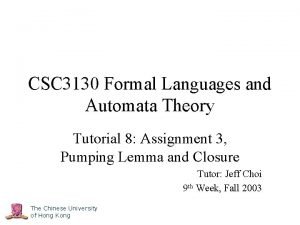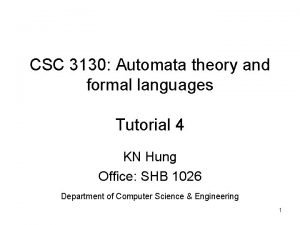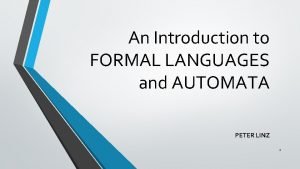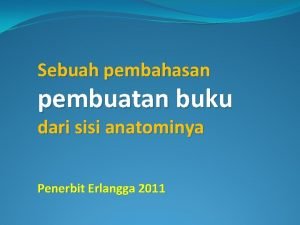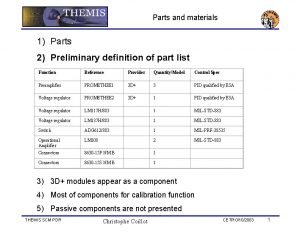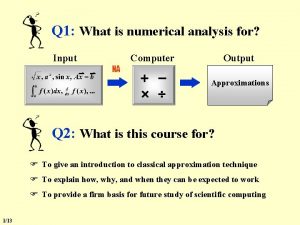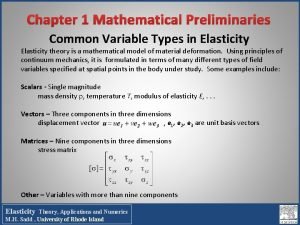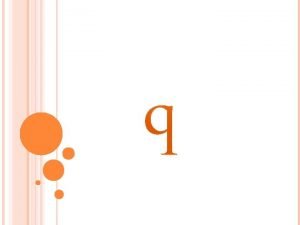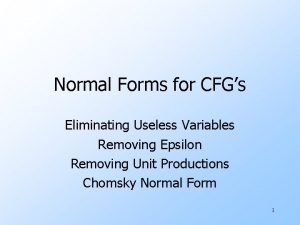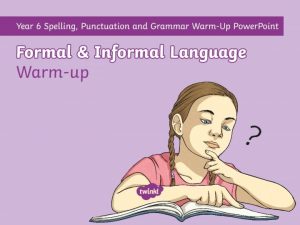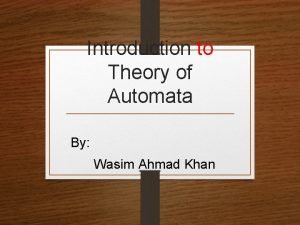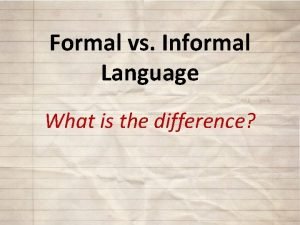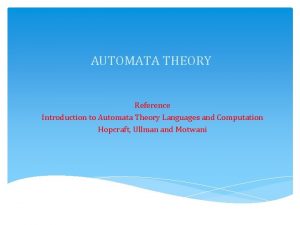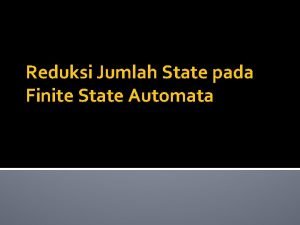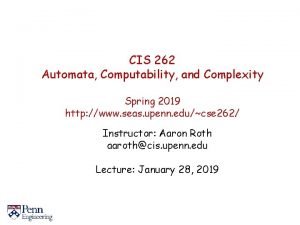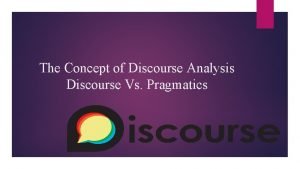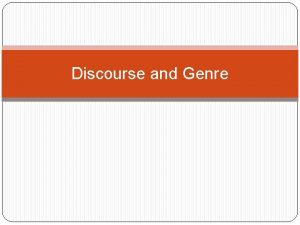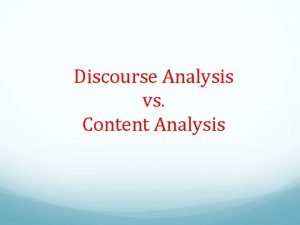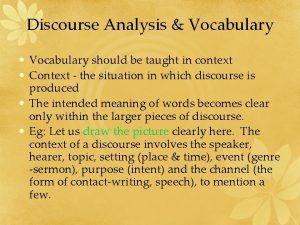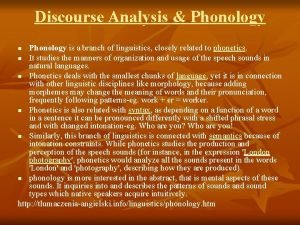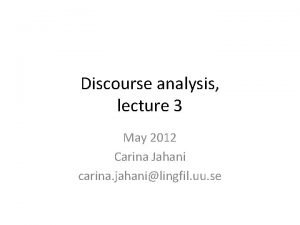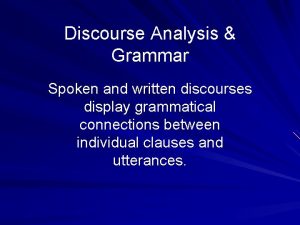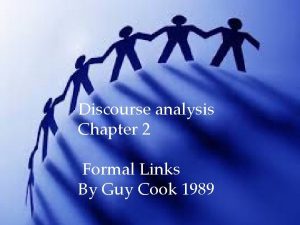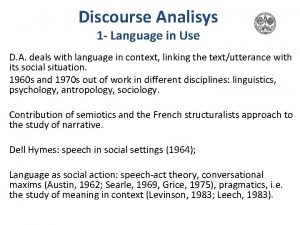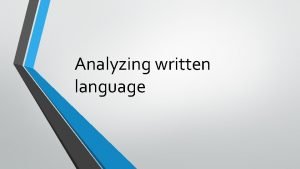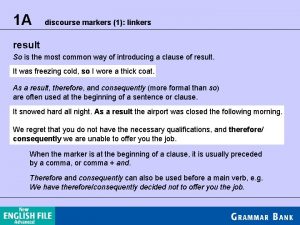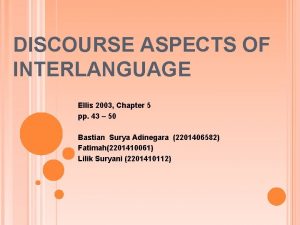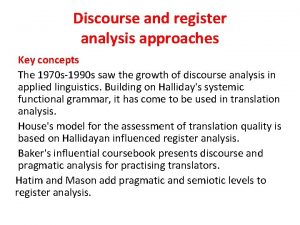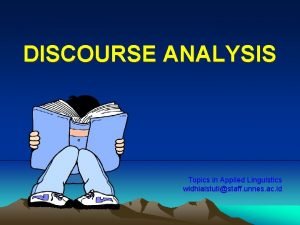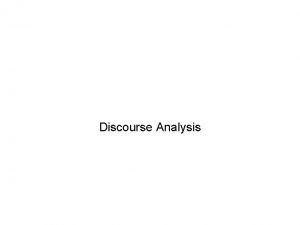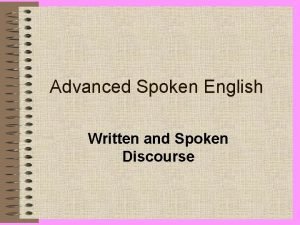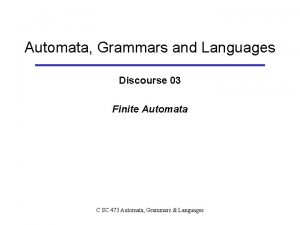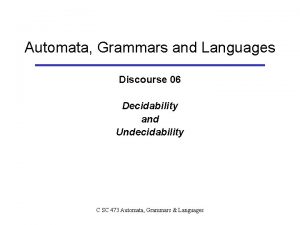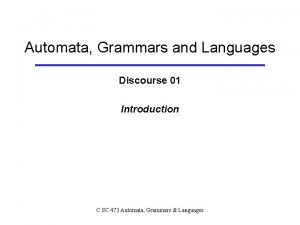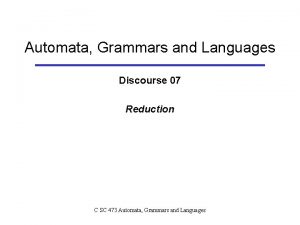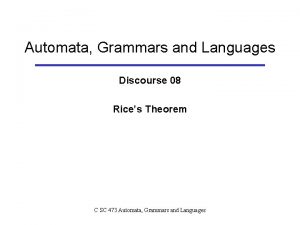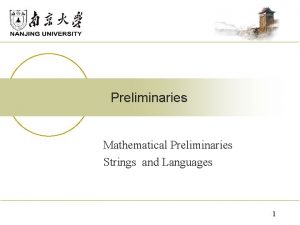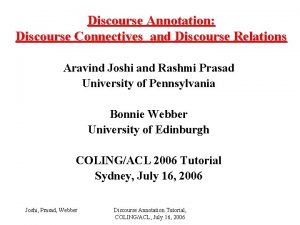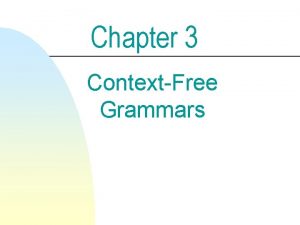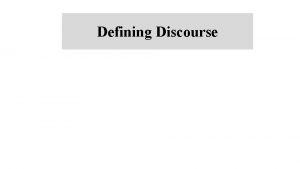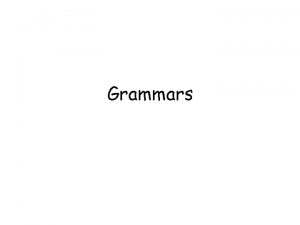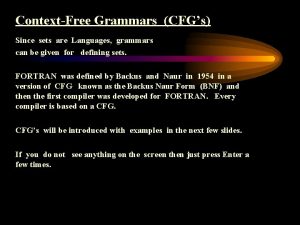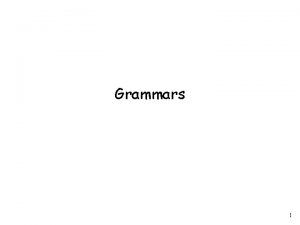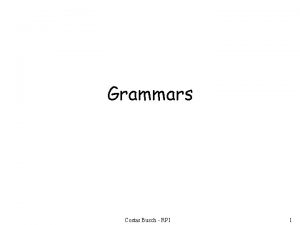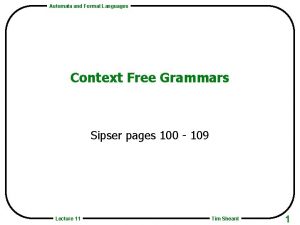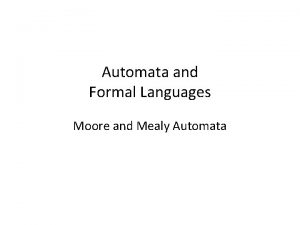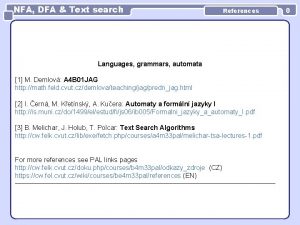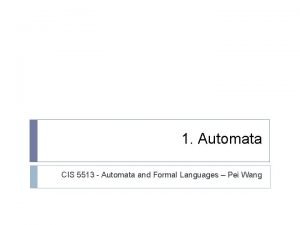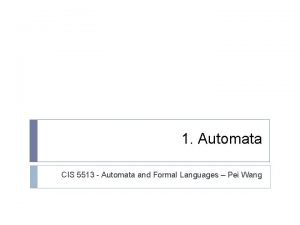Automata Grammars and Languages Discourse 02 Preliminaries C















































- Slides: 47

Automata, Grammars and Languages Discourse 02 Preliminaries C SC 473 Automata, Grammars & Languages

Sets • Set: primitive notion of “aggregate”—from which all of mathematics and logic can be constructed • One small hierarchy of concepts in this course: derives Grammar real sequence string function rational relation integer tuple set C SC 473 Automata, Grammars & Languages 2

Sets (cont’d) • Predicate P(x): a statement about a variable x that is true or false when x is replaced by a particular object n n P(x) = x is odd Main predicate for set-membership: “x A” • Some axioms of set theory n n Axiom of Extension: a set is determined by its “extension”: Axiom of Specification: For every set A and predicate P(x) there is a set of all elements of A for which P is true. • Ex: {x Z: x is positive and not prime} = {4, 6, 8, 9, 10, 12, …} C SC 473 Automata, Grammars & Languages 3

Sets (cont’d) • Operations and relations on sets n n n n subset proper subset union intersection complement difference size of set • Special sets n empty set natural numbers integers n n • Sets of sets n Power set C SC 473 Automata, Grammars & Languages 4

Logical Implication (Material implication) • R S If you do not pay us $1 M by midnight (R), we will shoot your ambassador (S) R S T ~pay T shot R S T F pay F ~shot T F pay T shot T ~pay F ~shot F C SC 473 Automata, Grammars & Languages T 5

Logical Implication (cont’d) • P Q If you pay us $1 M by midnight (P), we will not shoot your ambassador (Q) P Q T pay T ~shot T F ~pay F shot F ~pay T ~shot T T pay F shot C SC 473 Automata, Grammars & Languages P Q T F 6

Quantifiers • • • Ex: defining “big Oh” relationship between functions • Ex: continuity of a function at a point (“epsilon-delta defn”) • Abe Lincoln’s quote canfool(p, t) = can fool person p at time t C SC 473 Automata, Grammars & Languages 7

Quantifiers (cont’d) • Relationship between and • Ex: “cannot fool all of the people all of the time” • Ex: non-continuity at a point C SC 473 Automata, Grammars & Languages 8

Sets & Predicates (U =universe) • • • • • • Sets P= { x: P(x) } A B A-B P P =U U-P= x P P Q P=Q C SC 473 Automata, Grammars & Languages Logical Predicates P(x) A(x) B(x) A(x) B(x) ( x) P(x) true ( x) P(x) Q(x) 9

Tuples • • {3, 7} unordered pair; 2 -tuple (3, 7) ordered pair (3, 7) {{3, 7}, 3} (7, 3) {{3, 7} Generalize to n-tuple: (a 1, a 2, a 3, …, an) Defn. Cartesian Product A x B { (a, b) : a A b B } • Generalization: A 1 x A 2 x … x An C SC 473 Automata, Grammars & Languages 10

Binary Relations • Defn: a binary relation R from A to B is a subset of A B: • Defn: a function f from A to B, written f : A B, is a relation f A B that is single-valued, i. e. , • Defn: one-to-one (injection), onto (surjection), one-to-one correspondence (bijection) n See Definition 4. 12, p. 175, text. Also see below. C SC 473 Automata, Grammars & Languages 11

Binary Relations: 3 views set (postfix) relation (infix) predicate (prefix) (a, b) R a. Rb R (a, b) (3, 10) < 3 < 10 < (3, 10) (Charles, Andrew) is. Fatherof C SC 473 Automata, Grammars & Languages Charles is. Fatherof Andrew is. Fatherof (Charles, Andrew) 12

Why Relations? Generalize Functions. • Ex: functions • Ex: division with remainder E N N • Ex: circle C R R • Ex: Relational Database • Grammar “derives” relation C SC 473 Automata, Grammars & Languages 13

Relational Calculus S R a b A C SC 473 Automata, Grammars & Languages B c C 14

Relational Inverse • • R A B ________ < Father. Of Divisor. Of Hits • • R -1 B A ________ > Child. Of Multiple. Of Is hit by R A R-1 B C SC 473 Automata, Grammars & Languages B A 15

The Calculus • A A • Proposition. If C SC 473 Automata, Grammars & Languages 16

Proving a Proposition about Relations • Thm. • Pf: (a) Let and by definition of . So Then and so Since (c, a) was chosen arbitrarily, (b) Let Then and So implying Hence Since (c, a) was chosen arbitrarily, (b) follows. � C SC 473 Automata, Grammars & Languages 17

Relational Properties R A B Relational calculus C SC 473 Automata, Grammars & Languages predicate calculus name 18

Family Relationships is Child of i c h b f g a d e Grandparent Great n Grandparent …Parent (of child with offspring!) Parent Sibling …Sibling or self! Sibling Self (er…asexual reproduction only …) C SC 473 Automata, Grammars & Languages 19

Family Relationships (cont’d) i Nephew, niece … or child Uncle, Aunt or … Child (w. offspring) c h b f g a d e 1 st Cousin Once Removed…or … 1 st Cousin Once Removed or … Parent or Grandparent Ancestor Transitive closure of P C SC 473 Automata, Grammars & Languages 20

Binary Relations on A to itself (A) • Ex: Theorem: C SC 473 Automata, Grammars & Languages 21

Properties of Name R reflexive R symmetric R transitive Defn. R an equivalence relation C SC 473 Automata, Grammars & Languages Relational Calculus reflexive, symmetric & transitive 22

A False “Proof” About Relations • Theorem? Clearly any symmetric and transitive relation R must be reflexive. Pf? : Assume that R is symmetric and transitive. Then By transitivity Since a was chosen arbitrarily, it follows that • What’s wrong? sym. a sym. & trans. b a b If ( a)( b) a. Rb is true, then the argument is correct! C SC 473 Automata, Grammars & Languages 23

Binary R A A a C SC 473 Automata, Grammars & Languages Digraphs b 0 -1 Matrices c d 24

Binary Relations, Digraphs, Matrices (cont’d) a C SC 473 Automata, Grammars & Languages b c d 25

Binary Relations, Digraphs, Matrices (cont’d) a C SC 473 Automata, Grammars & Languages b c d 26

Binary Relations, Digraphs, Matrices (cont’d) a b d c Repeats! C SC 473 Automata, Grammars & Languages 27

Binary Relations, Digraphs, Matrices (cont’d) a C SC 473 Automata, Grammars & Languages b c d 28

Transitive Closure (finite graph) a b d c a b c d a b C SC 473 Automata, Grammars & Languages c d 29

Transitive Closure Reachability • Defn: a reaches b in relation (digraph) R iff • Prop: a reaches b in R iff a. R+b • Thm: Let be a relation where Then Pf: Longest possible path in G(R+) that will not repeat an edge is of length n. This path will result in an edge in Rn. • Ex: may need to go all the way up to Rn a b c a C SC 473 Automata, Grammars & Languages b c 30

Strings and Languages • In this course, a “language” is simply a set of strings; a “programming language” is much more complex • alphabet - a finite set of symbols • String (word) over - finite sequence of symbols • - the empty or null string • |w| - length of string w n What is a string precisely? String w of length n is a function • String ops n n concatenation powers C SC 473 Automata, Grammars & Languages 31

Strings and Languages (cont’d) • = {w: w is a string over } (note: ) • Language L over : a subset L • Ex: = ASCII codes C SC 473 Automata, Grammars & Languages ( = blank = �40 = ) 32

Strings and Languages (cont’d) • Language ops n Set operators n Concatenation n Powers • Ex: C SC 473 Automata, Grammars & Languages 33

Strings and Languages (cont’d) • Language ops (cont’d) n n n Defn: Kleene Closure (Star) Note: Defn: • Ex: C SC 473 Automata, Grammars & Languages 34

Strings and Languages (cont’d) • Theorem: • Pf: • Ex: C SC 473 Automata, Grammars & Languages 35

Strings and Languages (cont’d) • Ex: C SC 473 Automata, Grammars & Languages 36

Methods of Proof • Construction: exhibit the object guaranteed by theorem. n Ex: Construction of a regular expression, given a FA. • Contradiction: To show P: Assume P and derive a contraction or clear falsity (“reduction ad absurdum”) n Ex: our proof of undecidability of the halting problem: assumed “halt” program existed and derived an absurd contradiction • Induction: to prove P(n) holds for all non-negative integers n: base (basis) step conclusion C SC 473 Automata, Grammars & Languages 37

Induction C SC 473 Automata, Grammars & Languages 38

A Rule of Inference base step conclusion k 0 Prove P(0) P(k) k k+1 k=n F Prove P(k) P(k+1) C SC 473 Automata, Grammars & Languages T P(n) • halts n • algorithm n P(n) 39

Kinds of Induction • Simple induction _________ • Equivalent _______________ • “Course-of-Values” Induction __________ C SC 473 Automata, Grammars & Languages 40

Ex: Induction Argument: Balanced Parens • Defn: The strings having balanced parentheses over {(, )} are defined (inductively) by: n n The empty string is balanced If w is balanced, so is (w) If w, x are balanced, so is wx Nothing else is balanced except by the above rules • Remark: a grammar for balanced strings is: • Examples: n n Balanced Unbalanced C SC 473 Automata, Grammars & Languages 41

Parentheses (cont’d) • Defn (C): A string w over {(, )} has the prefix property C iff • Note: the prefix property can be checked in a L-R scan of the string using a counter (this is what calculators do) • Thm: A string w is balanced iff it has the prefix property. n Comment: this iff ( , a logical equivalence) means we have to prove 2 directions s s If a string is balanced, it has the prefix property ( ) (Lemma 1 below) If a string has the prefix property, then it is balanced ( ) (Lemma 2) C SC 473 Automata, Grammars & Languages 42

Parentheses (cont”d) ( ( ( ) ) ( ( C SC 473 Automata, Grammars & Languages ) ) ( ( ( ) ) 43

Parentheses (cont’d) • Thm: A word w is balanced iff it has the prefix property. • Lemma 1: w balanced w has prefix property C. Pf: Induction on |w| Base: |w|=0 w= w satisfies C. Step: Let |w|=n. Assume (IH) all strings shorter than n that are balanced satisfy C. Let w be balanced. Two cases are possible: Case w=uv where u, v are balanced. By IH, u, v satisfy C. Then and so w satisfies C(a). Next consider a prefix s of w=uv. If s is a prefix of u then because by IH, then w satisfies C(b) for this prefix. C SC 473 Automata, Grammars & Languages 44

Parentheses (cont’d) If s = ut where t is a prefix of v then by IH, and so w satisfies C(b) in this case. Case w=(u) where u is balanced. By IH u satisfies C, and so clearly so does (u) � C SC 473 Automata, Grammars & Languages 45

Parentheses (cont’d) • Lemma 2: w satisfies C w is balanced. Pf: Induction on |w| Base: w= is balanced by definition. Step: Let |w|=n >0. Assume (IH) all strings shorter than n that satisfy C are balanced. Let w have prefix property C. Let x be the shortest prefix of w such that Such a prefix exits since w has this property. Case x=w Then w =(u) where u satisfies C. By IH, u is balanced, and so then so is w. Case xv=w with v . Now x satisfies C(a) by assumption and satisfies C(b) since w does. So by IH x is balanced. C SC 473 Automata, Grammars & Languages 46

Parentheses (cont’d) We claim that v has property C. Since and then and so v satisfies C(a). Suppose there were a prefix y of v such that Then Which would violate the prefix property of w. Thus it must be that So v satisfies C(b). By IH, v is balanced. Since both x and v are balanced, w=xv is balanced. � C SC 473 Automata, Grammars & Languages 47
 Regular grammars generate regular languages.
Regular grammars generate regular languages. What is discourse analysis
What is discourse analysis Csci 3130
Csci 3130 Formal languages and automata theory tutorial
Formal languages and automata theory tutorial Csc3130
Csc3130 Gtg stands for in automata
Gtg stands for in automata Automata theory tutorial
Automata theory tutorial Csci 3130
Csci 3130 Apa itu preliminaries
Apa itu preliminaries Preliminary materials
Preliminary materials Halaman preliminaries
Halaman preliminaries Mathematical preliminaries in numerical computing
Mathematical preliminaries in numerical computing Chapter 1 mathematical preliminaries
Chapter 1 mathematical preliminaries Path synoynm
Path synoynm Unrestricted grammar
Unrestricted grammar Handling questions in context-free grammars
Handling questions in context-free grammars How to remove epsilon productions from grammar
How to remove epsilon productions from grammar Unrestricted grammar is also known as
Unrestricted grammar is also known as Informal language definition
Informal language definition Length of a string in automata theory
Length of a string in automata theory Formal features of language
Formal features of language Central concepts of automata theory in flat
Central concepts of automata theory in flat Tujuan dari reduksi jumlah state pada dfa
Tujuan dari reduksi jumlah state pada dfa Cis 262
Cis 262 Difference between text and discourse
Difference between text and discourse What is discourse
What is discourse Pragmatic and discourse analysis
Pragmatic and discourse analysis Discourse and ideology
Discourse and ideology Planned and unplanned discourse
Planned and unplanned discourse Discourse analysis
Discourse analysis What is genre
What is genre Discourse and culture in pragmatics
Discourse and culture in pragmatics Content analysis versus discourse analysis
Content analysis versus discourse analysis Textual aspects of lexical competence
Textual aspects of lexical competence Discourse analysis and phonology
Discourse analysis and phonology Foregrounding and backgrounding in discourse analysis
Foregrounding and backgrounding in discourse analysis Display
Display Formal links in discourse analysis
Formal links in discourse analysis Field tenor and mode in discourse analysis
Field tenor and mode in discourse analysis Discourse and text
Discourse and text Linkers and discourse markers
Linkers and discourse markers Ellis 2003
Ellis 2003 Register in discourse analysis
Register in discourse analysis Discourse analysis topics
Discourse analysis topics Discourse analysis and vocabulary
Discourse analysis and vocabulary Discourse and syntax
Discourse and syntax Schema and script in discourse analysis
Schema and script in discourse analysis Types of spoken discourse
Types of spoken discourse



